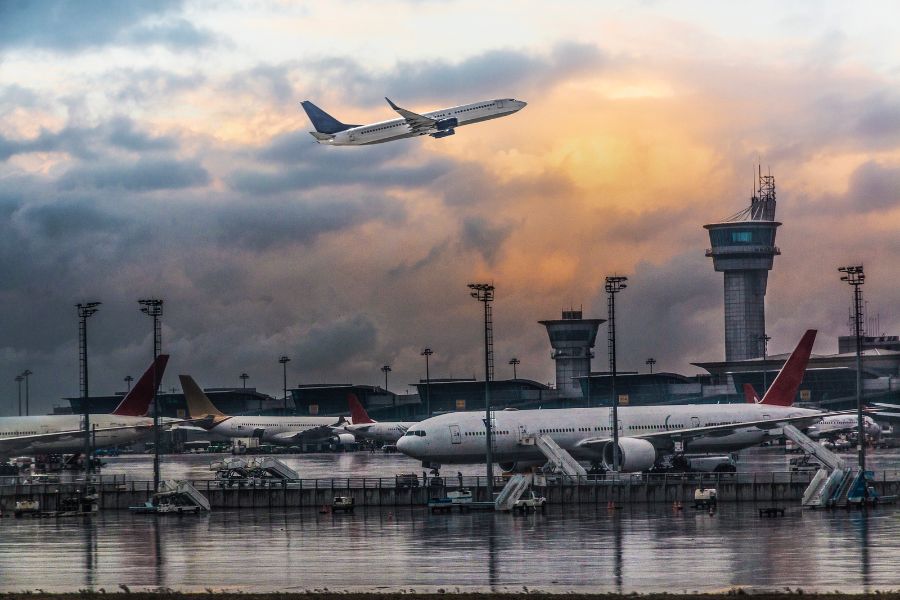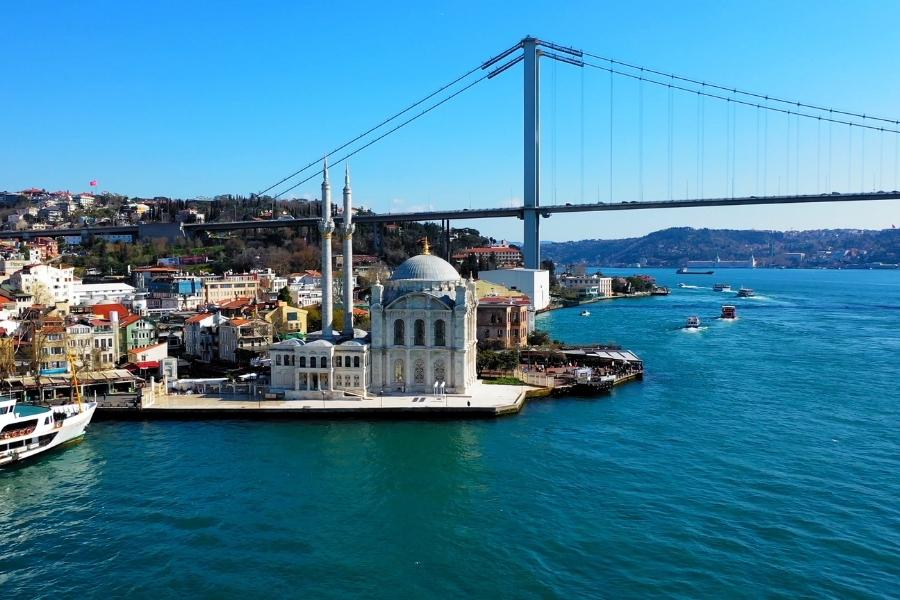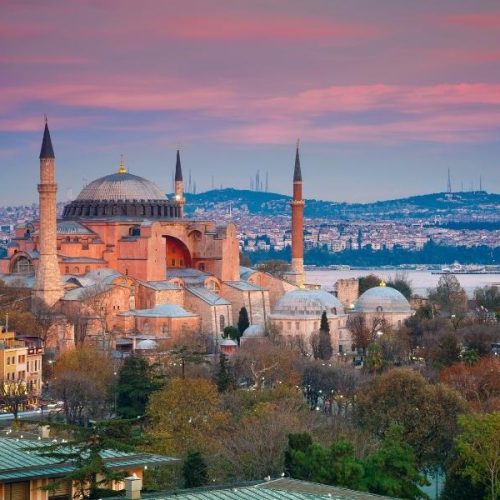Travel Guide: Visiting Istanbul from USA
USA to Istanbul: Your Essential Travel Guid
Istanbul is a very popular destination for Americans and is also frequently visited by travelers. Since this is a frequently traveled route, we have created this guide to help you plan every aspect of your trip, from the best sites to see to the best way to get around the country.

Plan Your Trip in Advance
When embarking on a journey from the United States to Turkey, meticulous planning becomes an indispensable tool. It encompasses a spectrum of vital tasks ranging from securing flight tickets and lodging arrangements to formulating a comprehensive itinerary that highlights the essential attractions to explore. Ingrained in this planning process is the imperative research into the destinations earmarked for visitation, scrutiny of the weather forecasts, and the prudent act of pre-booking various necessities such as tours, entertainment events, and dining reservations. These preparations ensure that you will have a well-organized and gratifying trip.
Exploring Istanbul fully may take at least four days to do justice to its numerous attractions. While two days is the minimum, a week could still leave you wanting more, given the city’s extensive offerings.
It is important to note that a budget of around $83 USD per person per day (or $580 USD for a week) is a reasonable estimate for travelers to use as a reference for how much the trip will cost.
Flying to Istanbul
The easiest cities in the United States to fly to Istanbul are New York, Los Angeles, Washington D.C., San Francisco and Chicago. Each of these airports has at least one non-stop flight every day to Istanbul. Common airlines are United, Turkish Airlines and Lufthansa. The non-stop flight time ranges from 9h45m to 13h5m, depending on your city of departure. The flights tend to cost around $1,000 round trip on average.
There is also the option to fly to a European country first and then fly from there to Istanbul. This option may take longer, but can also be the more cost effective way.
Istanbul has two significant international airports for travelers. Istanbul Airport (IST), positioned on the European side in Arnavutkoy, stands as the city’s largest and most bustling airport. Its proximity to Taksim Square, approximately a 45-minute drive away, has earned it the moniker ‘Istanbul Grand Airport’ or IGA. Notably, IST serves as a primary arrival point for passengers flying with Turkish Airlines and those journeying from Europe.
Conversely, Sabiha Gokcen International Airport (SAW) operates as the city’s second major aviation hub, strategically situated on the Asian side. It is approximately 40 kilometers away from Taksim Square, necessitating around 60 minutes of travel. SAW plays host to flights from the Middle East, including carriers like Emirates and Qatar, in addition to Turkey’s own Pegasus Airlines.
To ensure a seamless travel experience, travelers must exercise caution when selecting the appropriate airport for their flight. These two airports are separated by a distance of 80 kilometers, requiring a minimum of 75 to 90 minutes for transit between them. Shuttle buses are available for inter-airport transfers, but an incorrect choice might lead to inconvenient circumstances. Therefore, travelers are strongly advised to perform a triple-check of their reservations and diligently confirm their departure airport to avoid any potential disruptions.
For those who are living in the USA, if you are planning on driving to the airport and leaving your vehicle while you are visiting Istanbul, then check out ParkFellows. ParkFellows is an online comparison site for parking at airports across the United States. So if you are looking to save on parking at LAX, JFK or even SFO, then explore their site for the best rates.
Travel Visas
Most nationalities, including citizens from the United States, Australia, and Canada, require a tourist visa to enter Turkey. The e-visa scheme, introduced in 2013, is accessible to citizens from over 40 countries. However, citizens from the European Union do not need a visa. A standard multiple-entry visa allows a 90-day stay within a 180-day validity period.
Visa on arrival (VOA) is an alternative, but it usually involves waiting at the airport, which can be time-consuming, particularly at Istanbul Airport. The e-visa is often more cost-effective, except for some nationalities, such as US passport holders.
To obtain a Turkish e-visa, fill out a straightforward online form. Keep in mind that the process can sometimes be a bit glitchy, but e-visas often arrive in your inbox promptly, usually within an hour. Don’t forget to print your e-visa to present at immigration.
Travel Requirements for American Citizens
Individuals holding American citizenship are eligible to visit Turkey, provided they possess the requisite entry authorization. Typically, this entails acquiring an e-Visa, which serves as an electronic visa for US nationals. The e-visa application process can be conveniently conducted online, involving the completion of a brief questionnaire and the submission of a digital copy of one’s passport for verification. This efficient procedure facilitates entry for US citizens planning to explore the cultural treasures of Turkey.
Ensure you have a passport valid for at least six months beyond your arrival date and a visa. Visas typically cost $50 USD and are available from the Republic of Turkey Ministry of Foreign Affairs website.
Safety
Istanbul is generally safe for tourists, with cities like Istanbul and Ankara, along with coastal
resort towns such as Bodrum and Marmaris, having low crime rates and political stability.
Travel insurance is crucial for any trip, especially when traveling from the United States, where it is common knowledge that medical expenses can be substantial. It’s wise to get insurance in advance to ensure coverage in case of unforeseen incidents.
While Istanbul is considered safe, incidents of pickpocketing and the high cost of local healthcare make having travel insurance a sound decision.
Best Time to Visit Istanbul
The best times to explore Istanbul are mid-spring (April and May) and the fall months (September to October). During these periods, you can enjoy mild weather with temperatures ranging from approximately 62°F to 77°F.
Conversely, December through February is the cheapest time to visit, but be prepared for rainy, snowy, and chilly conditions, with temperatures in the high 30s to high 50s.
July and August are the busiest and hottest months, which coincide with the European Union’s vacation season, so it’s advisable to avoid these months.
Where to Stay in Istanbul
Pre-booking accommodations is essential, particularly during peak travel seasons when properties tend to fill up quickly, and last-minute reservations can come at a premium.
The Fatih District is a popular choice for tourists, known for its proximity to a multitude of attractions, including museums, mosques, and bazaars that are easily accessible on foot or via public transportation.
How to get around Istanbul
When exploring Istanbul, one might contemplate renting a car for further adventures outside the city. However, it’s advisable to collect the vehicle on the city’s outskirts, a service often provided by companies like Local Rent. Istanbul’s city center, with its frenzied traffic, is not conducive to driving, and it’s a notion best avoided.
The city boasts an affordable, user-friendly, and reliable public transportation system. Travelers can efficiently move about via the metro, trams, buses, ferries, and the charming dolmus minivans, which can be a delight. These shared taxis, whose name translates to “stuffed,” tend to be packed with passengers, especially during peak hours like the morning rush between 8 and 9:30 am.
Public Transportation
To access public transport, acquiring an IstanbulKart is highly recommended. Various card options are available, all valid for the metro, buses, trams, and ferries. The Anonymous IstanbulKart, ideal for tourists, can be purchased at kiosks, newsstands, and metro stations for 50 TRY (non-refundable). This versatile card can be used by multiple individuals, up to five people.
The cost of a single IstanbulKart fare is 7.67 TRY, a significant savings when compared to the 15 TRY charged for a one-time journey ticket. It is important to note that metrobus fares differ based on the number of stops, while metro fares remain constant.
Taxi
Istanbul’s taxi system is well-organized and features three categories with varying price points. Yellow taxis are standard and offer the most economical fares at 6.3 TL per kilometer, along with an initial switch-on fee of 9.8 TL. Turquoise taxis provide a premium service at a 20% higher cost, while black taxis, typically luxury vehicles, are twice as expensive as their yellow counterparts.
Taxis in Istanbul generally operate with meters, making them a reliable option for tourists to hail on the streets. Nevertheless, it’s essential to remain cautious, as taxi scams do occur. As a result, many travelers and locals alike prefer to utilize ride-hailing apps for added security and convenience.
Rideshare Apps
After a series of legal disputes, Uber re-entered the Turkish market in 2021. Travelers have reported positive experiences with the service, citing short wait times, friendly drivers, and competitive fares. Payment is often made in cash, so it’s advisable to carry smaller bills. Alternative ride-hailing options in Istanbul include BiTaksi and Itaksi, with the former offering contactless card payments for added convenience.
Top Places to Visit in Istanbul
With a city that boasts 39 districts, a population of 15 million residents, and over 1,700 years of history, Istanbul’s sheer scale can be mind-boggling. Visitors often find themselves pondering where to embark on their exploration of this remarkable city.
Arriving in Istanbul is a unique experience for travelers, as it instantly engulfs them in its vibrant ambiance. Turkey’s largest metropolis has a captivating way of encircling visitors, immersing them in its diverse culture and historical tapestry. Istanbul tends to evoke a sense of tranquility upon arrival, encouraging tourists to let go of preconceived notions and embrace the flow of this extraordinary destination. Below are some of the top recommendations for places to visit in Istanbul
Hagia Sophia
Hagia Sophia, also known as Ayasofya, holds a significant place in Istanbul’s history and is recognized as one of the world’s most remarkable monuments. This architectural wonder has a diverse past, reflecting the shifting religious landscape of the region.
Originally constructed during the 6th century CE (532–537) under the patronage of Byzantine Emperor Justinian I, Hagia Sophia began as a Christian church. In the subsequent centuries, it underwent transformations, serving as a mosque, a museum, and then a mosque once more. This transition is evident in the structure’s design, featuring both the Islamic elements of minarets and inscriptions and the opulent Christian mosaics.
For visitors, it is crucial to be mindful of prayer times when planning their Hagia Sophia visit. Arriving during prayer hours can result in substantial waiting times. Prayer schedules are conveniently displayed at major mosques or can be checked online.
To avoid long queues, it is advisable to plan a visit approximately 30 to 40 minutes before the mosque’s scheduled closing time. Fridays, during the Jumu’ah prayer, tend to be exceptionally busy and often marked by crowds and chaotic conditions. Travelers should also be aware that if their visit coincides with Ramadan or another Islamic holiday, prayer times may differ, potentially leading to more extended mosque closures during the day.
Topkapi Palace Museum
The Topkapi Palace stands as an iconic destination in Istanbul, drawing in millions of visitors from around the globe. Within this expansive complex, the Ottoman Imperial Harem and the treasury of the sultan are particularly popular attractions, often bustling with tourists. Situated in the eastern part of the Fatih district in Istanbul, Turkey, the Topkapı Palace, also known as the Seraglio, functions as a vast museum and library. For over three centuries, from the 1460s until the completion of the Dolmabahçe Palace in 1856, this magnificent palace served as the administrative hub of the Ottoman Empire and was the primary residence of its sultans.
The Blue Mosque
The Blue Mosque, officially known as the Sultan Ahmed Mosque, stands as a remarkable testament to Ottoman-era history in Istanbul, Turkey. This architectural wonder was meticulously constructed between 1609 and 1617 during the reign of Ahmed I and continues to serve as an active mosque in the present day.
What sets the Blue Mosque apart is its unique distinction as the sole mosque in Istanbul boasting six minarets. Notably, when it was originally built, this feature stirred controversy among the faithful. At that time, the city of Mecca possessed the exclusive honor of having six minarets, leading to concerns in the Muslim community that such a design might be perceived as a display of disrespect towards the Kaaba (Ka’bah).
Grand Bazaar
The Grand Bazaar in Istanbul proudly ranks among the world’s most extensive and time-honored covered markets. Comprising a vast expanse with 61 sheltered streets and a wealth of over 4,000 shops, it draws in a daily multitude of visitors ranging from 250,000 to 400,000. As the most ancient and largest historical bazaar globally, the Grand Bazaar was erected upon the directive of Sultan Fatih, primarily to generate income in support of the Hagia Sophia.
Situated amidst the Nuruosmaniye and Beyazıt Mosques, Cevahir, and Sandal Bedestens, this historical marketplace offers a diverse array of goods, from ceramics and Turkish lamps to tea, rugs, spices, jewelry, and delightful Turkish confections. It stands as a cherished emblem of Istanbul’s rich commercial heritage.
Galata Tower
The Galata Tower, officially designated as the Galata Tower Museum, graces the Beyoğlu district of Istanbul, Turkey, as a notable relic of Genoese architecture. Originally conceived as a watchtower, its construction unfolded atop the eminent Walls of Galata. In contemporary times, this tower has been reimagined into an exhibition space and museum, standing as a resounding symbol of both Beyoğlu and Istanbul.
Architecturally, the tower embodies the masonry rubble stone system, featuring an exterior adorned with an intricate stone mesh pattern. Historically, the Galata Tower played an indispensable role in the city’s defense, offering unobstructed surveillance from within the protective fortifications.
Furthermore, the tower’s narrative is one of remarkable versatility. It transitioned into a fire detection tower during the era of the Ottoman Empire. Subsequently, under the rule of Sultan Suleiman ‘The Magnificent,’ it underwent a transformation into a place of incarceration. This rich and varied history underscores its significance as a cherished historical and cultural landmark within Istanbul.
What to Eat in Istanbul
Istanbul’s Grand Bazaar, which opened in 1431, is an excellent destination for souvenir shopping, with approximately 3,000 shops spread across 61 streets. So during your time in Turkey, be sure to enjoy some of the local culinary delights, such as:
- Pomegranate juice – street food sold on carts throughout the city is pomegranate juice.
- Simit – It’s a pretzel-like, twisted bread, much like a bagel, covered in sesame seeds – slightly chewy with a crunchy exterior.
- Turkish Delight – The most common flavor is rose
- Pide – a Turkish pizza. It’s a delicious flatbread, grilled and crispy, topped with ground meat and/or veggies.
- Doner Kebab – large piece of meat that is roasted vertically as it rotates.
- Manti – ravioli stuffed with lamb, tomato sauce and yogurt
Fun Facts About Istanbul
Before going to Istanbul, it may be nice to familiarize yourself with a few fun facts about Turkey!
- In Turkey, tipping is customary, with 10% being the standard gratuity for restaurants and bars. For taxi drivers, it’s common to round up to the nearest lira when paying in cash.
- One unique fact about Istanbul is that it’s the only city in the world that straddles two continents: Europe and Asia, divided by the Bosporus strait.
- The Grand Bazaar, dating back to 1431, is one of the world’s largest and oldest covered markets, offering an extensive shopping experience.
- Istanbul, also known as Byzantium and Constantinople, served as the capital of both the Byzantine and Ottoman Empires.
- For a city of its scale, Istanbul has a way of making travelers feel at ease, encouraging them to embrace its unique character and history.






